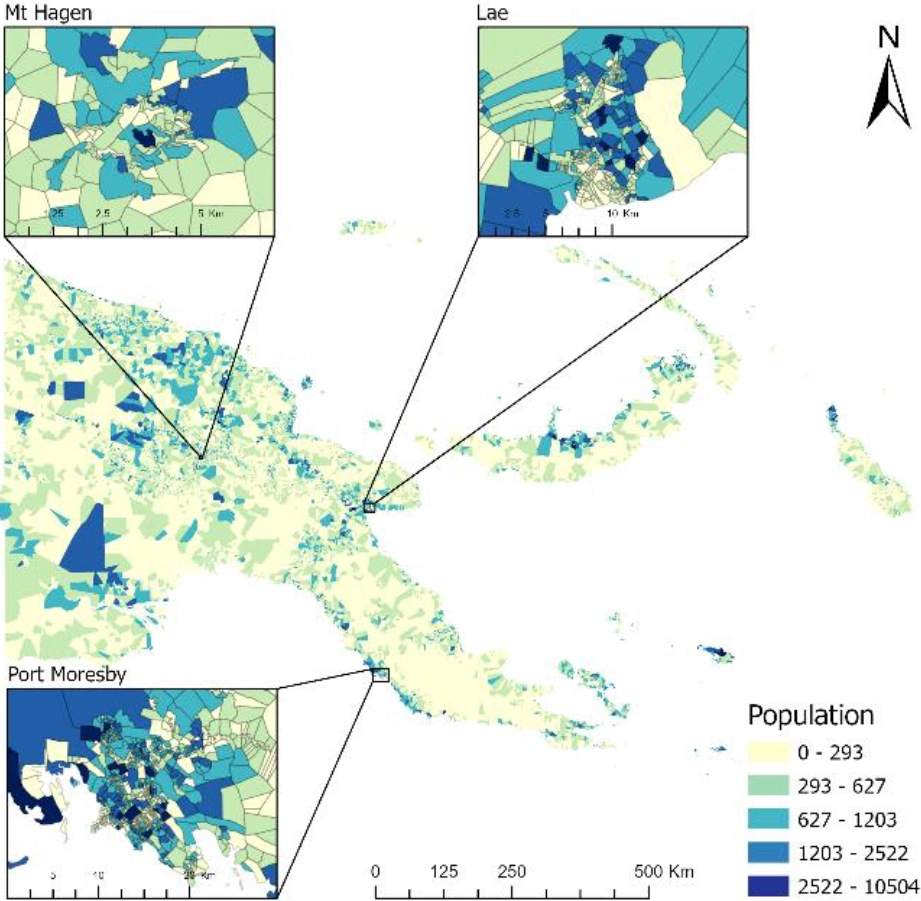New National Statistics
Subnational population data underlie all areas of effective governance, from equitable resource allocation, to strategic planning, to ensuring that services are delivered to all. Regularly conducted population and housing censuses, updated through administrative statistics typically form the basis for the production of such national demographic statistics. However, conflict, financial limitations, political challenges and poor access can be a barrier to undertaking such data collection. Many countries over the past few years have therefore turned to partnership with WorldPop to produce small area population estimates that can provide these data in the absence of recent census data. In this case study report we outline examples from our work with the National Statistics Offices of Papua New Guinea, South Sudan, Burkino Faso and Mali.
Papua New Guinea (PNG) held its fourth census in 2011, and preparations were underway for their fifth census, but the Covid-19 pandemic disrupted these. Up to date information was needed on local level populations to enable robust and accurate planning for upcoming development decisions, and to support election planning. WorldPop co-developed small area modelled population estimates with the PNG national statistics office and UNFPA, drawing on satellite mapping of buildings and recent sample population count data from household surveys. The estimates have been adopted by the PNG government and used in country planning processes. Moreover, the data are forming a valuable component of the planning and preparation efforts for PNG’s next census, where WorldPop is continuing to play a supporting role.

South Sudan has been unable to conduct a national census since 2008, when it was part of Sudan, and significant population displacement has taken place since, making traditional approaches to population projections highly uncertain. In partnership with UNFPA, WorldPop supported the design and implementation of new population counts across the country in sample areas. These were then used as the basis for training and validating satellite-based small area national population estimates. The new population data were approved by South Sudan’s government and remain in use as official statistics.
Burkina Faso’s National Institute for Statistics and Demography (INSD) carried out its fifth population and housing census in late 2019, but security issues in the north and east of the country meant that some areas could not be fully enumerated. As part of the GRID3 program, and in collaboration with UNFPA, WorldPop co-developed methods for predicting population numbers in areas where enumeration could not take place and producing gridded estimates for the full country. These formed the official numbers published in the preliminary census.
Conducting a national population and housing census requires as comprehensive, recent and reliable data on population distributions as possible to support planning for implementation. The government of Mali were able to complete their pre-census cartography for most of the country, but certain areas were deemed inaccessible, leaving incomplete data for census planning. WorldPop partnered with the National Statistical Office of Mali (INSTAT) and UNFPA as part of the GRID3 program. The population counts collected as part of the incomplete census cartography phase were utilised to develop, train and test a Bayesian statistical model to construct small area population estimates for the inaccessible, leaving incomplete data for census planning. WorldPop partnered with the National Statistical Office of Mali (INSTAT) and UNFPA as part of the GRID3 program. The population counts collected as part of the incomplete census cartography phase were utilised to develop, train and test a Bayesian statistical model to construct small area population estimates for the inaccessible areas. This provided a complete set of population estimates that could then be used by INSTAT as the basis for implementing their national census in 2022.
Further information
- Papua New Guinea Population Estimates 2021 (National Statistics Office, PNG)
- South Sudan’s population estimated at 12.4 million (Radio Tamazuj, Sudan)
- The Population Seen from Space: When Satellite Images Come to the Rescue of the Census (Population)


